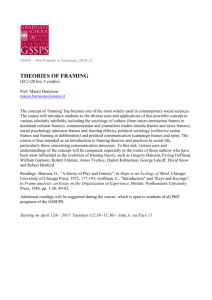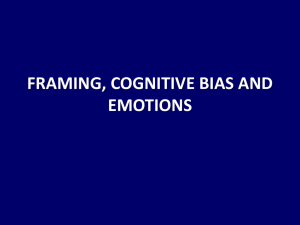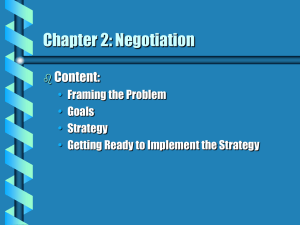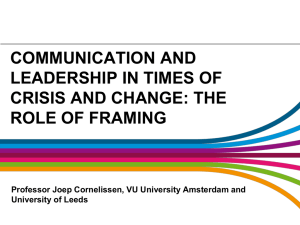3. The Research Process
advertisement
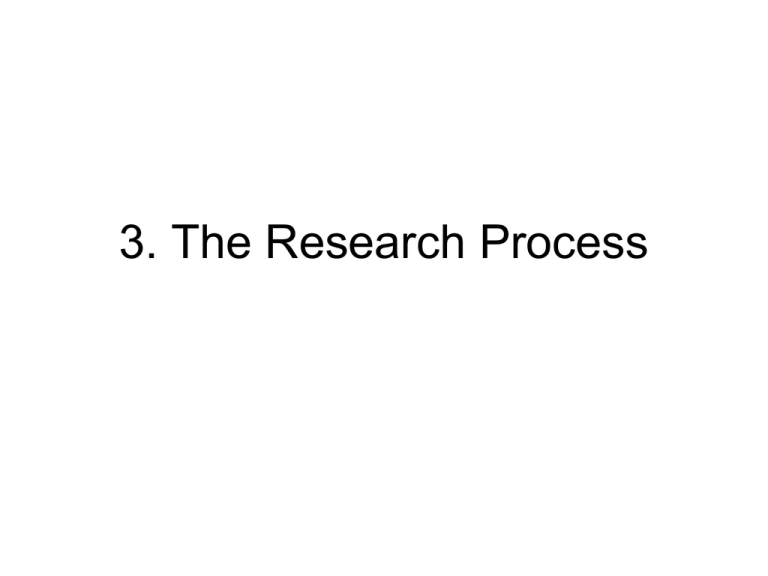
3. The Research Process a) A linear model „The scientific method“ (Hoover/Donovan 2008: 29) for a critique see Ragin 1997: 14-17) 1. 2. 3. 4. Identify variables Construct hypothesis (relation between variables) Reality test (measuring variables) Evaluation (compare hypothesis and empirical result) and generalisation 5. Suggestions (relevance of finding, possible distortions etc.) b) A circular model • Inductive-deductive cycle (McIntyre 2005: 35) c.) Ragin‘s model Ideas/Theory • Making sense of (the diversity of phenomena) social life • Applying general ideas to social phenomena and relate them to each other (impose some form of order) • may come from everywhere (everyday life, a novel, an observation, a conversation etc.) • In social science, abstract knowledge about social life is called “social theory” • There is a pool of ideas about social reality that is constantly made and remade (good ideas are passed on from generation to generation) Evidence/Data • All facets and features of social life offer evidence • The empirical world is limitless in detail and complexity • Social research thus involves a selection of evidence • Selection is biased, it can be contested • Selection quite often is theory/ideas driven Dialogue of Ideas and Evidence • Analysis: “breaking up phenomena into their constituent parts” (Ragin 1994: 55) - mostly deductive: starting from theory in order to classify and characterise social life • Synthesis: “putting pieces together to make sense of them” (Ragin 1994: 56) - mostly inductive: starting from social life, trying to see order and regularities (but often looking at parts of social life defined by analytical frames) Analytic Frames • Are derived from social theories • Constitute ways of seeing / looking at evidence – i.e. the perspective • Define a category of phenomena and provide conceptual tools for differentiating phenomena within the category Framing by case • Answers the question: What is this a case of? – Classification (put object of investigation into a class of similar cases) • Examples: – Yugoslavia under Tito • As a communist regime • As a succesful containment of ethnic conflict – The American Civil War • Military conflict between civilians • Battle over slavery • Conflict about state rights • The answer to this question (framing by case), determines the internal framing (framing by aspect) Framing by aspect • Characterisation of your case • Systematic account of major feature of your case (and other cases in the category) – Example: succesful containment of ethnic conflict • Strategies to contain ethnic conflict – Resource redistribution – Divide and rule • Number of ethnic minorities • Relative position (politicial/economic) of majority vis-à-vis minorities • Nature of political competition - one-party state - Multi-party system • Indicates how cases within a category vary • Helps to see aspects present and absent Images • “… are the product of the effort to bring coherence to data” (Ragin 1994: 68) • … are constructed when evidence is brought together in a meaningful way • “… are formed from evidence […] summarize it, and relate it back to the ideas that first motivated the collection of evidence • Images do not always correspond with the initial analytical frame, they may challenge it (lead to revision) Images (2) • … are idealizations/generalizations – We abstract from information about empirical cases – Ex: Ghetto (idealtype) • … embody explanations – Ex: Image of “Exodus” (collective wilful abandonment explains ghetto) • … are guides to further research – Images may change analytic frames – Image may pose new questions Retroduction • Interaction between images and frames (between induction and deduction) • Retroduction in imaging: evidence that build the image is usually defined as relevant by ideas and analytic frames • Retroduction in framing: F. is based on vast body of systematized evidence (not possible without prior knowledge of evidence and making sense out of it) • Retroduction proper: Theory (abstract, general, vague) → analytic frames (but no one-to-one expression). Images may help to - clarify and refine initial framing - reject initial framing Representations • Dialogue of ideas and evidence (via frames and images) culminates in representations of social life • Representation as a framed image (analogy: photograph) • Representations are finished products (but products of a long process in which frames and images are created and recreated) • Representations usually entail some kind of explanation • Forms of representation: monographs, journal articles, textbooks, lecture, newspaper article etc. Process and Strategies of Social Research • Frame and image interact differently in different research projects • Fixed frames: theoretically derived hypothesis is implemented in analytical frame (no change of frame during research process) – – – – Theory testing Also: making predictions, identifying broad patterns quantitative research Ex: Rational Choice Voting • Category: Voters • Aspects: educational level, occupation etc. (correlation to voting behaviour expected) • Directly translated into data collection and analysis Process and Strategies of Social Research (2) • Flexible frames: shows researcher where to look (which aspects to look at) without being to specific (as to possible causal relations) • Evidence based images are used to refine the frame • Goal: exploring diversity • Common in comparative research • Ex: study of tyranny – Case: tyranny – Aspects: ideology, support base, degree of cruelty, etc. – Relations between these factors become apparent during the collection of the data and are used to refine the frame (e.g. more ideology, more cruelty) Process and Strategies of Social Research (3) • Fluid Frames: researchers want to limit the influcence of preconceived ideas – Readily get rid of initial frame once evidence based images emerge – Start with alternative frames – Do not know what is their case a case of • Goals: especially “Give Voice”, but also “Interpreting culturally or historically significant phenomena” • Qualitative research The Challenge of Social Research • Clear specification of ideas that guide research • Systematic examination of evidence used to build images and representations • Challenges: – construct representations that are instructive – Contribute to ongoing theoretical debates and embrace the depth of empirical evidence – Construct representations that are “new and true”

